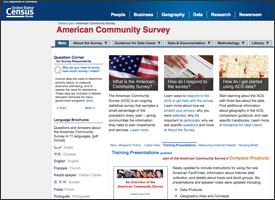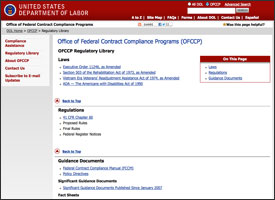I have had the privilege of becoming more involved with the Industry Liaison Group (ILG) on both a national and local level. If you are not plugged into ILG, please check the National ILG website and find the contact information for your area.
The most recent Indiana ILG meeting included informative sessions around Census Data and OFCCP updates. Since the majority of our Members are Federal contractors, I wanted to share meeting highlights from two sessions.

Presented by Patrick Nooren, Biddle Consulting Group
If you have ever met or heard Patrick present, you know he is a fountain of knowledge. Patrick is one of those rare breeds who loves to crunch data. His presentation was full of insights and information about Census Data as well as the American Community Survey (ACS) EEO Tabulation, and how it compares to the 2000 Decennial Census.
The old Decennial Census was a sampling of individuals with about 1 out of 7 people having received a long-form to complete. Surveys were sent to all households nationwide and the “usual residence” rule was used to establish residence.
This old way had a few problems – the data got old quickly, it represented a snapshot as of April 1, 2000 and didn’t reflect rapid changes in the population/workforce.
The new American Community Survey (ACS) was launched in 2005 to replace the decennial census long-form and it is an EEO tabulation sponsored by four Federal agencies: EEOC, DOJ, OFCCP, and OPM. The surveys are sent to 250,000 different households each and every month. The residency is established using a “current residence” rule.
The new way is a compilation of responses from over a 5-year timeframe, because there are confidential requirements and a granular breakdown of the date (i.e., by geography + occupation code).
Five year estimates are based on larger sample sizes of more households, resulting in a much smaller margin of error and therefore providing more accurate estimates.
The ACS provides geographies and databases that are potentially relevant to contractors, which include: occupation (487 including Santa Clause and the Easter Bunny), industry, age, educational attainment and earnings. The data can be used to assign EEO codes and residence recruitment area for your AAP. The data can be found Census Methodology page. Patrick broke down a lot of this data and put it together in his own easy to read Excel spreadsheet. Feel free to reach out to Patrick to obtain a copy of this handy dandy spreadsheet of data!
2) OFCCP Update
Presented by Bradley Anderson, Regional Director, Midwest Region, US DOL OFCCP
Our final presentation was an overview of what has been happening with the Office of Federal Contract Compliance Programs (OFCCP), including the following information about changes in directives:
305 – Functional Affirmative Action Programs
POLICY: Effective December 17, 2012, Federal contractors and subcontractors seeking an agreement to develop, implement and maintain functional AAPs must follow the procedures outlined in this directive.
306 – Criminal Record Restrictions
BACKGROUND: Racial and ethnic disparities are reflected in incarceration rates. In light of these racial and ethnic disparities, contractors should be mindful of federal antidiscrimination laws if they choose to rely on job applicants’ criminal history records for purposes of employment decisions. Hiring policies and practices that exclude workers with criminal records may run afoul of such laws, which prohibit intentional discrimination on the basis of race, national origin, or other protected bases, and policies or practices that have a disparate impact on these protected groups and cannot be justified as job related and consistent with business necessity.
307 – Reviewing Compensation Systems & Practices
BACKGROUND : OFCCP is issuing this directive in support of its ongoing policy commitment to address pay discrimination by federal contractors and subcontractors. This directive specifies the procedures OFCCP field investigators use for reviewing contractor compensation systems and practices. It clarifies and improves OFCCP procedures in further support of the agency’s efforts to align pay discrimination enforcement with longstanding principles under Title VII of the Civil Rights Act of 1964 (Title VII).
Mr. Anderson went onto provide some guidelines for “Keeping OFCCP @ Bay” a Federal Contractor should commit to:
- CEO/C Suite – Need to make EO a priority
- EO/AA accountability and top – What gets measured is what gets done
- Monitoring and self-audit reviews.
- Consistency is key – Consistent Personnel Policies
- Be pro-active
In addition Bradley provided the following advice/updates.
- The new regulations will be more stringent on recruiting.
- Keep track of what you get from your efforts.
- Make sure you have anti-harassment policies and procedures.
- The FMLA poster has been revised to include military family.
- A new version of the Form I-9 was released. Beginning May 7, 2013 employers must only use the new version.
He discussed how the agency moved from Active Case Management mentality to Active Case Enforcement and is looking at more than hiring. As a result, the Midwest Region cases have decreased from 4,435 in FY10 to 3,495 in FY12. He explained that the Conciliation Agreements have gone up from 30% in FY10 to 45% FY12 (and most of those were onsite because you have a 1 in 2 chance of a Conciliation Agreement from an onsite). He explained that Desk Audits have gone up from 12% in FY10 to 27% in FY12 and that you have a 1 in 4 chance of a Desk Audit resulting in a Conciliation Agreement.
The settlements have gone up from $40M in 2010 to $49M in 2012 and cases have increased from 97 or 13% in 2010 to 138 or 30% in 2012 – a lot of these are compensation settlements.



Seems like the data reported in the news needs to be better. This blog takes a look at the problem. http://www.statisticsblog.com/2013/03/minding-the-reality-gap/